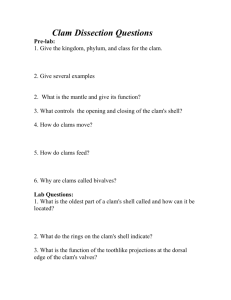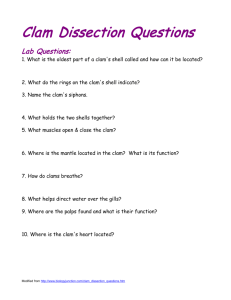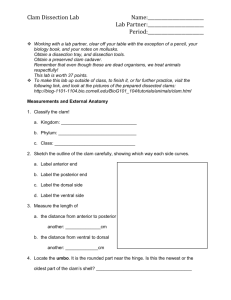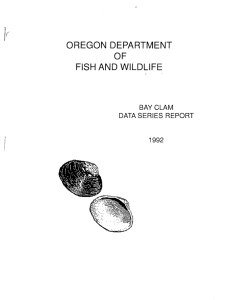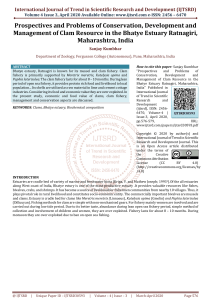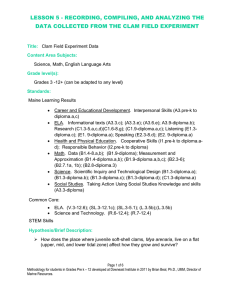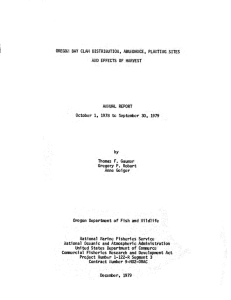Summary of the Workshop of June 30, 1975
advertisement
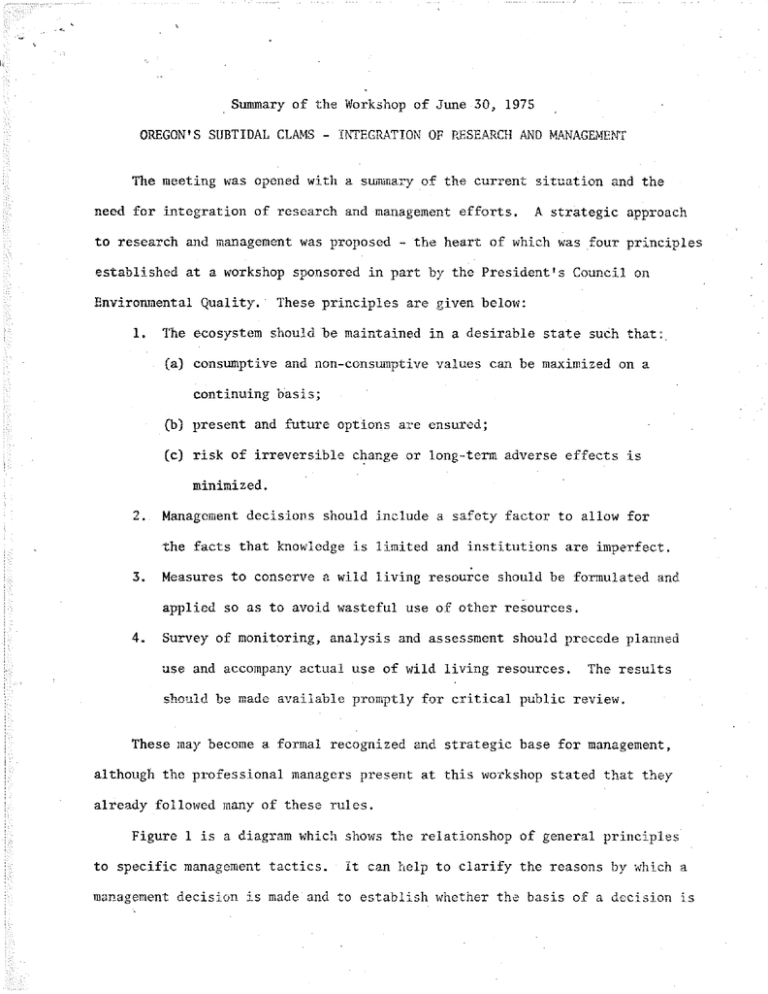
Summary of the Workshop of June 30, 1975
OREGON'S SUBTIDAL CLAMS - INTEGRl,TION OF RESEARCH AND MANAGEMENT
The meeting was opened with a sUillillary of the current situation and the
need for integration of research and management efforts.
A strategic approach
to research and management was proposed -the heart of which was four principles
established at a workshop sponsored in part by the President's Council on
Environmental Quality.
1.
These principles are given below:
The ecosystem should be maintained in a desirable state such that:.
(a) consumptive and non-consumptive values can be maximized on a
continuing basis;
(b) present and future options are ensured;
(c) risk of irreversible change or long-term adverse effects is
minimized.
2.
Management decisions should include a safety factor to allow for
the facts that knowledge is limited and institutions are impel'fecL
3.
Measures to conserve a wild living resource should be formulated and
applied so as to avoid wasteful use of other resources.
4.
Survey of monitoring, analysis and assessment should precede planned
use and accompany actual use of wild living resources.
The results
should be made available promptly for critical public review.
These may become a formal recognized and strategic base for management,
although the professional managers present at this workshop stated that they
already followed many of these rules.
Figure 1 is a diagram which shows the relationshop of general principles
to specific management tactics.
It can help to clarify the reasons by which a
management decision is made· and to establish whether the basis of a decision is
Page 2
ecological, political, economic, or a combination.
Input from biologists filters its way through many levels--but the commissioners make the final decision.
Previously the FCO was limited to looking
only at the biology of the species.
They can now examine the socio-political
situation as well and think about managing for optimum sustained yield instead of
maximum harvest of biomass. The tools used in management are: seasons, quotas, bag
limits, gear restrictions to make a fishery "inefficient", limited entry,
and licensing.
Specific items mentioned to study in regards to subtidal clams are:
1)
Location and extent' of subtidal beds
2)
Species composition
3)
Age structure
4)
Biomass
5)
Economics
f
-_
I
•.
6)
Ecological niches
7)
Spawning times and rel'easers
8)
Effect of harvest on habitat
9)
Methods, of improving the habitat
10)
Recruitment into harvested areas.
Construction of a simulation model of the clam fishery was proposed.
The project would function as a forum for integrating the present knowledge
,
on clams, as a way to involve interested managers and researchers in a mutual
project to understartd each other's poirtt-of-view, and to produce a functioning,
d namic model to test management policies.
It is possible that a model of
ne subtidal clam population would help in the design of research on the
esource.
Current research on Oregon clam populations has so far been in the form
Page 3
of observations designed to locate the subtidal beds and identify species.
Current information on abundance is therefore not yet complete.
Preliminary
work was summarized in two handouts--a literature review and a Summary of
Natural History of the major hardshell clams--along with the mention that
data on larvae, currents, associated infauna, and physical and chemical features
of major clam habitats were thought to be important.
Discussion revealed that the economic feasibility of a commercial clam industry in teIms of primary and secondary jobs, market volume, and market
stability is of prime importance in assessing the social implications of clam
maIlagement policies.
In accordance with Heisenberg's principle that the
observer influences the observation, the current .researchis influencing
the effectiveness of some management options by stimulating interest in clam
harvesting.
Political, social and economic constraints upon the management of the
resource were briefly covered.
Social constraints involve people problems . . The
local possessiveness of people and the problem of deciding appropriate usages
are examples.
Economic constraints involve the existence of a market, the
available profit margin, the employment mUltiplier for a given industry, the
effect of commercial operations on recreation, and alternative jobs available
to local operators.
Political constraints involve bot!, the social and
economic considerations.
The political process may respond to the biological
constraints, but does not always follow the best biological use.
Agencies
must stay within defensible economic and social bounds or the public
will take the issue directly to the legislature.
Indian fishing rights and navigational dredging and filling projects will also
influence management practices.
These are all important reasons to determine
the extent and ecology of the resource.
Page 4
It also appears important that the fishery be efficient, but efficiency
does not always imply large size.
The technology permitted in a commercial
clam harvest must be ecologically "efficient" as well as money and energy
efficient.
Harvest methods ought not to substantially hinder resettlement of
the bed, or waste non-commercial species.
Good management would allow only
harvest methods that become commercially non-feasible before the resource approaches
exhaustion, and thus are self-corrective.
The thread running through the workshop appeared to be that management of
the Oregon subtidal clam resource requires a balance between biological and
economic constraints, and that more information on both realms is required at
this point.
Key questions involve the relationship of the subtidal to the inter-
tidal clams; the life history, evolutionary strategy, and ecology of the clams;
the economic implications of harvesting; jurisdictional rights; and dredging
projects.
It was apparent that cooperative research and management programs are fruitful for both parties and allow an effort much broaaer in scope than otherwise
possible.
O
6
.
F
E
ir:l
F
i6r
"Bt
3 ? :r
Eo
EgE
a Bg
&
n
9
D!t
>7
CP
?v-
aa
OE
\
\rrD
\.
OF
\-
\-
€o
o
Oa
qci
Lo
ilF
'
Efr
,<
ob
r
6::
t s : F
;"9
s< {
F g
'
' ; F X
oF
3i.<
o
fE
FT
EF
FE
ro
\\---
n
o
339
"rB
o
q5 D=Ft
r
e53
3BF
E O F
.sd
r.'€
€:t
",=
n
',-i
. r
4't
D
f o 5 o
a.r i t
'o
GT
d qG
5i
IE
:{
o
o
d
o
!
a
Fii
q
s
o
€ €U
a ti- tl
5C
dt
=t
IF
tr2
\
ql
=-
FF
EF
3 Zn2lJ
i- ^a
&g
<t
t5i
f.€:
3o 1
6-9
G.t
Ff{
dE=
6if
fFE
o*
r
\_
SF
U
<
E'E;
e
t
oB
Ef
\
xx
q
E$d
.rg
h
6't d'
*f?
t-tr Y.
gx
OTF
o
{>
FP
AA
.iT
EE
= ' H
Fi
f4>
9 ::{
(
EF
F A!,
* $ 6-,
:Fd
FI
, \ . J :
a!
fg,
.t:
lg{p
J}
flF
!'5
FF
4q
g9
dE
EIF
p=.
?>
gE[$
'+
EfETE
d
9"F
q3,
tsg
dR
<E
o
FO
ts0
:;'
ri
E>
30
,i
t<
O6
O FD
bD
F<
D !t
{oF
Irog
' 5- l
<5
'o
AJ
?=
!l
ot
,gF
! it
.OF
. ot
t-
'3
OD
?)
:-5
C; B
ncN
/
\"
s
it e
o€
=*:
Ot
ot<
ol'
ot
-Ht
9Jl
5 00
f n€
It
95X
\
/
\
Ii
o
I
I
I
I
I
E:
"EI
sg E'
r
\
F9
ntr
\.
\
\





